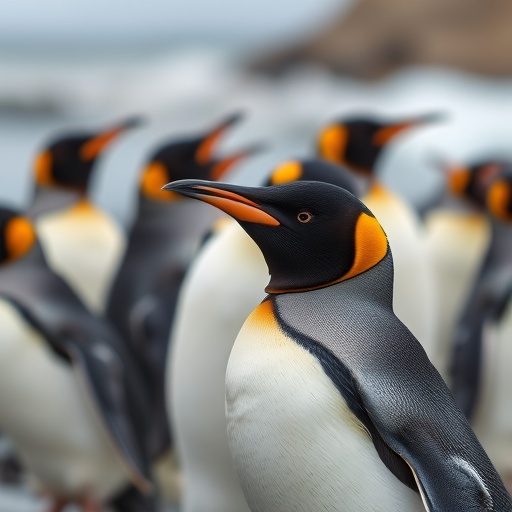In a groundbreaking study recently published in Global Change Biology, researchers have unveiled alarming evidence that the survival of penguin species across the Southern Hemisphere hinges critically on reassessing how climate change impacts are evaluated. Traditionally, conservation efforts and scientific inquiries have focused on isolated extreme climate events. However, this comprehensive new analysis demonstrates that the cumulative effects of these events—occurring simultaneously or sequentially—pose far greater risks to penguin populations and their habitats.
The pioneering international team, led by the Institut de Ciències del Mar (ICM-CSIC) alongside the Laboratoire LOCEAN-IPSL (Sorbonne Université) and Phillip Island Nature Parks, engaged in the first-ever quantitative, multi-habitat assessment encompassing all 18 penguin species residing in the Southern Hemisphere. Their extensive analysis captured a three-decade timeline, meticulously compiling climate data relating to extreme events such as marine heatwaves, severe storms, heavy precipitation, and terrestrial heat extremes. This holistic approach identified the most vulnerable penguin species and geographic “hotspots” where ecosystems are increasingly imperiled.
One of the study’s primary revelations is the uneven spatial distribution of extreme climatic events, which do not impact all penguin habitats equally. Notably, African, Snares, Emperor, Adélie, and Galápagos penguins emerged as the most susceptible to the cumulative burdens of these climate pressures. With climate models projecting rising intensity, duration, and frequency of such extremes, the prognosis is daunting for these and other penguin populations. The interplay of land-based and marine extreme events further exacerbates stress on penguin ecology, affecting fundamental behaviors such as reproductive success and foraging efficiency.
The integrative methodology employed in this study marks a significant advancement in bioclimatic risk assessments. By combining data on marine heatwaves, extreme wind events, terrestrial heat spikes, and unusually heavy rainfall, the researchers constructed a composite exposure index that more accurately reflects ecological realities. This framework moves beyond the simplistic evaluation of single-event impacts and instead quantifies the complex, synergistic pressures that wildlife and ecosystems endure as climate extremes accumulate.
Miriam Gimeno, a leading doctoral researcher from ICM-CSIC, emphasized the urgency of recognizing cumulative climatic stressors: “Penguin habitats are increasingly subjected to overlapping extreme events. Understanding these compound impacts is essential because they affect population resilience in ways isolated incidents simply do not capture.” These overlapping threats can reduce breeding success rates, disrupt key feeding opportunities essential for chick nourishment, and ultimately decrease population viability over time.
This research also extends its implications beyond penguins, offering a powerful analytical tool for conservationists studying other species vulnerable to multidimensional climate pressures. Co-author Camila Artana from LOCEAN-IPSL underscored the broader significance: “Our findings reveal the geography of risk not only for penguins but likely for numerous Southern Hemisphere species facing the same escalating climate volatility.” Thus, this research delineates critical bioregions where adaptive management and conservation efforts should be prioritized.
In response to their findings, the authors propose a tripartite conservation framework aimed at mitigating ecosystem vulnerability worldwide. The initial stage involves identifying priority hotspots experiencing heightened or rapidly escalating exposure to multiple extreme events. The second stage requires integrating additional local stressors—including fisheries exploitation, coastal urbanization, and tourism pressures—which often magnify the detrimental effects of climate extremes. Lastly, the framework advocates for adaptive, flexible management strategies grounded in continuous environmental monitoring and updated climate data projections to remain effective under shifting conditions.
Among the suite of management recommendations are calls for enhanced environmental protections in Antarctica, stricter fisheries regulations especially in areas affected by marine heatwaves, and habitat restoration projects targeting breeding grounds severely impacted by terrestrial heatwaves and extreme rainfall events. These targeted interventions could serve to buffer penguin populations against some of the worst consequences of climate change-induced environmental instability.
Andre Chiaradia of Phillip Island Nature Parks highlighted the practical conservation implications of the study: “By delineating which species and regions face the greatest cumulative climatic risks, we provide a roadmap for targeted, proactive management actions. Securing the future of wild penguin populations depends on informed, spatially explicit conservation planning that is responsive to rapidly evolving climate challenges.” This emphasis on spatial precision in conservation priorities heralds a new era in climate adaptation strategies.
The significance of this research extends to global biodiversity and ocean health concerns. Penguins serve as sentinel species, their well-being indicative of broader marine ecosystem conditions. Protecting them from the escalating risks posed by cumulative climate extremes echoes into the health of coastal and oceanic ecosystems worldwide. The intensification of marine heatwaves, for example, threatens not only penguins’ prey species but also disrupts entire food webs supporting biodiversity and fisheries critical to human livelihoods.
The cumulative nature of climate extremes—with overlapping heat, storm, and precipitation disturbances—represents a complex stress regime unlike any single-factor impact previously studied. This reveals an urgent need for science and policy to shift towards integrated risk frameworks that capture interactions among multiple stressors operating simultaneously or in close succession. Failing to do so risks underestimating the severity of climate change impacts on fauna like penguins and the ecosystems upon which they depend.
In conclusion, the study sends a compelling call to action to the scientific community, conservation agencies, and policymakers alike. It demands a paradigm shift towards evaluating and managing cumulative climate risk, with an urgent focus on those species and regions identified as most vulnerable. The future of penguins, and by extension the Southern Hemisphere’s diverse marine ecosystems, hinges upon our ability to comprehend and respond effectively to these compounded climatic hazards. Conservation strategies that adapt dynamically to emerging data and integrate multifaceted stress factors will be essential for ensuring long-term resilience in a rapidly warming world.
Subject of Research:
Animals
Article Title:
Cumulative Extreme Events Threaten Penguin Habitats Across the Southern Hemisphere
News Publication Date:
23-Oct-2025
Web References:
http://dx.doi.org/10.1111/gcb.70562
Image Credits:
Ana Sotomayor (UTM-CSIC)
Keywords:
Environmental sciences




